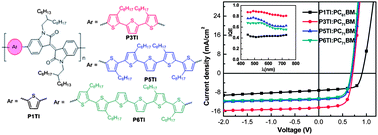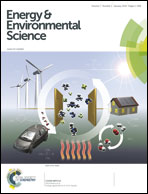Structure–property relationships of oligothiophene–isoindigo polymers for efficient bulk-heterojunction solar cells†
Abstract
A series of alternating oligothiophene (nT)–isoindigo (I) copolymers (PnTI) were synthesized to investigate the influence of the oligothiophene block length on the photovoltaic (PV) properties of PnTI:PCBM bulk-heterojunction blends. Our study indicates that the number of thiophene rings (n) in the repeating unit alters both polymer crystallinity and polymer–fullerene interfacial energetics, which results in a decreasing open-circuit voltage (Voc) of the solar cells with increasing n. The short-circuit current density (Jsc) of P1TI:PCBM devices is limited by the absence of a significant driving force for electron transfer. Instead, blends based on P5TI and P6TI feature large polymer domains, which limit charge generation and thus Jsc. The best PV performance with a power conversion efficiency of up to 6.9% was achieved with devices based on P3TI, where a combination of a favorable morphology and an optimal interfacial energy level offset ensures efficient exciton separation and charge generation. The structure–property relationship demonstrated in this work would be a valuable guideline for the design of high performance polymers with small energy losses during the charge generation process, allowing for the fabrication of efficient solar cells that combine a minimal loss in Voc with a high Jsc.


 Please wait while we load your content...
Please wait while we load your content...